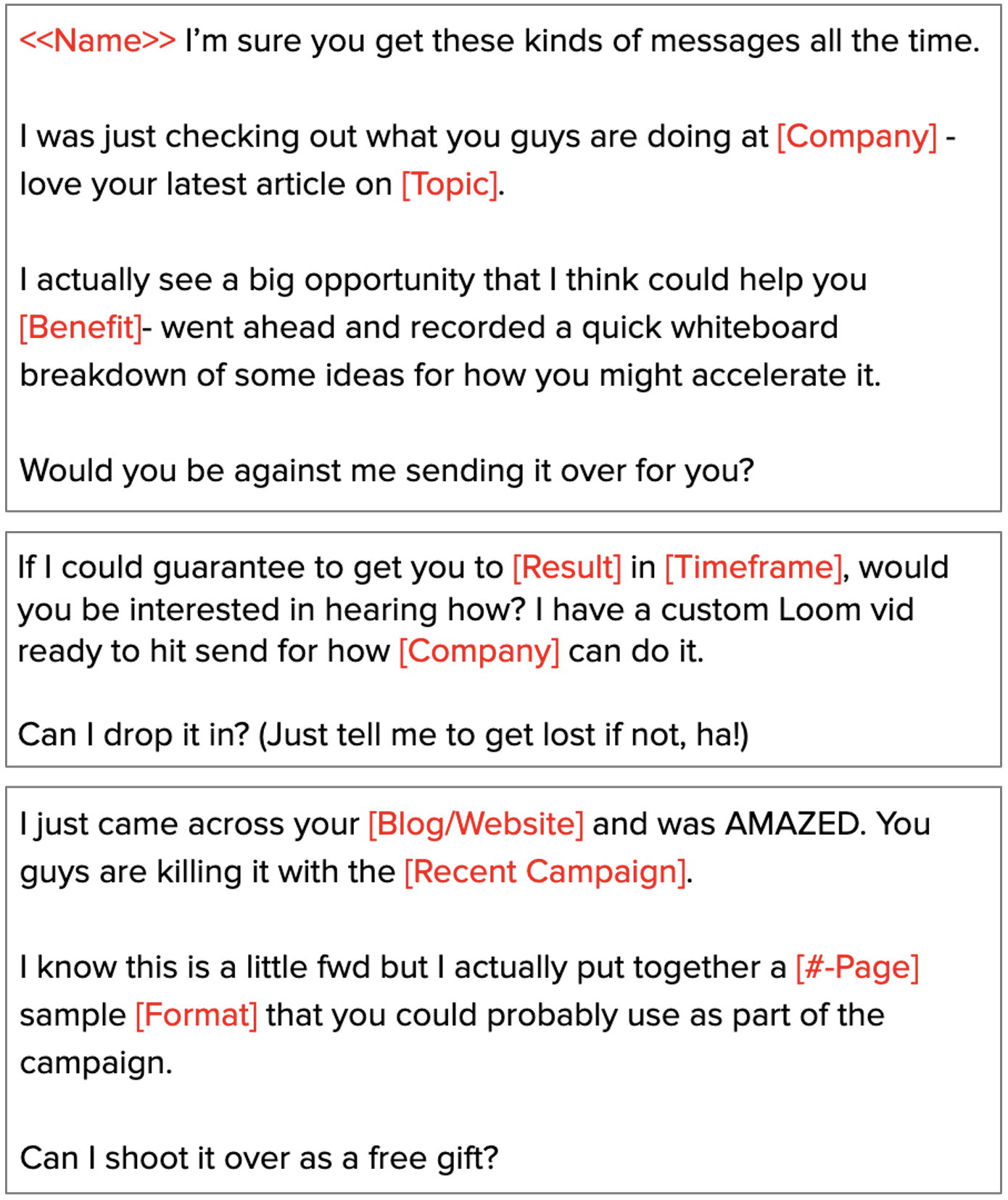Your cart is currently empty!

How to Write Copy That Triggers Recipients to Respond
Are you thinking about human psychology in your prospecting work?
Are you crafting pitches that are geared to trigger a response from recipients (instead of causing them to ignore you)?
The main rule with cold email, InMail, DMs, and even ad CTAs is to avoid tactics (and words) that 99% of other people are using. Anything that sounds generic or impersonal and you’re going to get ignored.
Most are failing miserably with their cold outreach (and falsely assume that a two-responses-out-of-a-hundred hit rate is the the best they can hope for).
We have to change how we prospect if we want to change our outcomes.
That starts with the strategy – then bleeds into technique.
Prospecting strategy
Before jumping into tactics, there are three things you have to hit on with every single initial outreach message to give yourself the best chance for a response:
- Speak differently than what people are used to. Be casual.
- Always be disarming, connecting, and empathizing.
- Get to the value now – first line of the first message. If you’re going with a hard sell, then drop numbers/promises/results right away. No fluff.
From a high-level standpoint, if I were coming into your business as a consultant, here’s immediate items I’d look to refine in your outreach strategy as we evaluated opportunities for improvement.
- I’d look at the best-converting channel, what’s the first touch, what kind of follow-ups are being sent, is value being communicated quickly, and how is the ask being made?
- I’d nix anything that sounded one-size-fits all and replace it with verbiage that feels natural and neutral so your team comes across as advisors who are there to help, not to sell.
- I’d develop an every-other-day conversation cadence to keep the dialogue going.
- I’d A/B test inviting new contacts to join a community (or content channel) where you nurture at scale (versus asking for a call up front).
- I’d immediately incorporate selfies, video messages, and voice memos to supplement text-based messages.
Once the strategy was in place, then we get to sending/execution.
3 prospecting tactics for 2024
You have to stay on top of outreach-arbitrage “trends” before they’re adopted by the masses (at which point your audience has already become desensitized).
By this time in 2025, the examples I’m going to drop in a minute will likely be all outdated.
Here’s three current tactics which are working well right now:
1. The custom gift (DM or Email)
Open with a personalized gift. Share that you’ve already proactively created a free audit, evaluation or resource specially for them and that you’d like to send it over. Here’s one template I share in my upcoming online course:

These work because you’re offering to give something for nothing.
You’re proactively offering complimentary value in the form of some utilitarian asset in exchange for their attention.
If the gift packs enough of a punch (and avails a need they may not know they even have), they’ll reply. Then you can set up a call to connect.
The psychology behind why it works: It’s all about curiosity and reciprocity, here – creating an imbalance in the value exchange by giving so much up-front without expectation for it to be reciprocated
2. The group invite (DM)
Instead of pitching your offer, pitch your VIP group. When everyone else is straight selling, share a personalized invite to an exclusive forum where high-level knowledge is being shared behind-the-curtain every day.
With these, I like the following format: avoid “hi” or “hey” and say something different; compliment the recipient; briefly state what happens in your group or why they should want to join; then end with an invite.

A good amount of my upcoming book is centered around using private groups for economical mass nurturing. Pre-register for updates here.
The psychology behind why it works: It’s all about FOMO – framing your group as a high-level “mastermind” or “community” where folks gather and converse to help each other level up
3. The “Re: Thread” (Email)
This one is my favorite for email. Here’s what you do: have your coworker or business partner send you an informal email first, asking you to reach out to a desired prospect directly. Then hit “reply” to that email and insert the prospect’s email address, moving your colleague to CC. Craft a casual message in the body saying that your coworker asked you to reach out and would they like to learn more or connect.
The email comes in feeling like a natural, ongoing conversation. The informal “re” in the subject line makes it seem like an continuation on a thread from your colleague (or, to the recipient, an existing thread with a peer which disarms them enough to take a look).
This is a clever workaround to a generic cold email that sort of absolves you from needing to feel like you’re intruding and makes it feel more natural than a me-too email pitch people are used to.
It’s sort of like, “okay, they’re just following through with what their boss or partner asked them to do, and this clearly isn’t some automated email. Let me see.”
The psychology behind why it works: Seeing the “re” in the subject line triggers curiosity because we don’t want to miss emails from our peers; it also makes the recipient feel desired – like someone else wanted to reach out to them, effectively separating the sender from the pitch
I hope these messaging frames and templates help to spur some ideas and tactical takeaways for your business.
📘 Grab your copy of CONTENT CAPITALIST here.

Leave a Reply